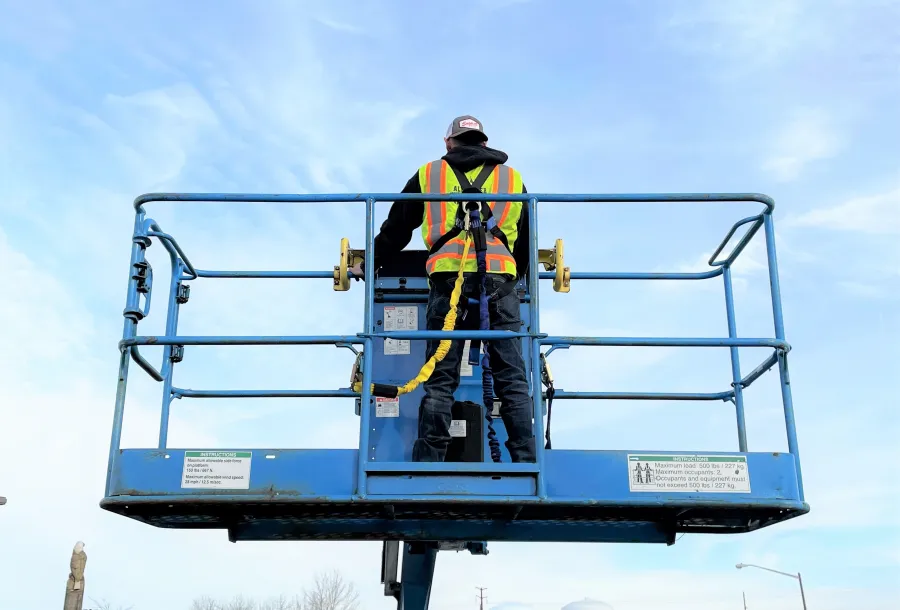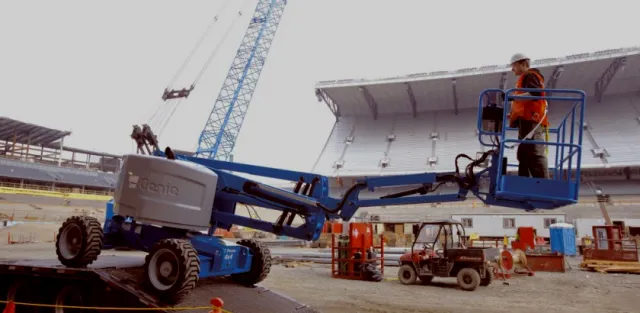Keep Your Job Moving in Winter
Cold temperatures and snow mean it is time to make sure your aerial lifts are prepared for extreme conditions.
There are steps you can take, to make sure your machines are ready to work every day, regardless of the temperature.
Make sure you have the right fluids for cold weather work
Before winter begins, make sure you have added the proper lubricants in the, hydraulic system, engine and transmission and check to make sure engine antifreeze is sufficient for conditions.
Manufacturers provide guidance for operating aerial lifts in winter months based on the temperature range you expect your aerial lift to be operated in.
For information on the recommended lubricants and fluids for your specific make and model, consult the operators and service/maintenance manuals and or contact the machine manufacturer.
Make sure you have the proper accessories for your machine to start and operate in the winter months
There are cold weather packages and accessories available such as block heaters, battery blankets, hydraulic tank heaters, pan heaters and freeze plug heaters.
Make sure to determine what accessories are needed to operate your equipment for your specific job site conditions by reading your operator’s manual and contacting the machine manufacturer and or local dealer.
Be sure to inspect cold-weather accessories frequently for proper operation.
Having the right equipment accessories can be the difference in a successful days work and failing to get the job done on time
Proper Lift Storage in Winter is Very Important
Once your equipment is on the jobsite, there are steps you can take to make sure it continues to perform to its full capabilities.
If possible, it is recommended that machines be stored in an enclosed facility when not being used. There are several advantages to enclosed storage over leaving machines out in the open.
Storing your equipment out of the elements protects it from being covered in snow and ice which means that your crew will not have to take the time to clean accumulated frozen precipitation.
Machines will be easier to start and the battery will last longer when stored inside as well.
Cold Temperature Start Up for Engine Powered Lifts
Be sure to allow equipment time to warm up properly. This could take 10 minutes or longer and gives the oil a chance to flow through the system and heat up hydraulic components.
The engine and transmission function better if given enough time to warm up before operating.
It is important to note that manufacturers do not allow under any circumstances, aerial lifts to be operated below -40 degrees F.
Important Things to Consider When Operating Battery Powered Lifts in Cold Temperatures
Some battery-powered lifts, are designed to be used in cold environments, such as a refrigerated warehouse or outdoors in the winter. Check the operators manual to determine if yours is a cold environment machine.
Keep in mind cold weather can affect battery performance which can result in slower functioning of battery powered lifts.
Cold temperatures can also reduce the life of the battery charge by half, meaning you will need to charge the battery much more frequently. Keep batteries fully charged and as warm as possible.
Never charge a frozen battery. Charging a frozen battery could result in an explosion.
Additional Notes
Make sure to take into account heavy jackets and boots required for winter weather operation when determining total weight in the platform in order to stay within manufacturers required platform capacity limits.
Always remember to perform the required Pre-operation inspection, Function Tests as well as inspecting the workplace every time each new operator takes control of an aerial lift.
Ensuring you have the right equipment and accessories for the job will keep your jobsite operating to its full potential, no matter the weather.





